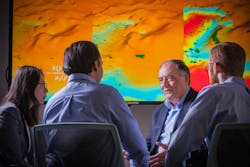Water conservation is a subject that few outside the energy industry naturally associate with oil and gas production. Instead, the debate around energy sustainability usually focuses on CO2 emissions.
However, both those elements are very much interconnected. For example, rising global temperatures are one of the key threats to water security — particularly in hot countries where supplies of this precious resource are already limited.1 In fact, the World Bank singles out water scarcity as one of the greatest risks to economic progress, poverty eradication and sustainable development globally, highlighting that nine out of 10 natural disasters are water-related.2
Put simply, our planet requires the same commitment to water conservation as that applied to combating climate change. Industries must adopt measures to reduce the amount of water they use for their operations.
One of the ways in which we avoid the waste of this precious resource is by using seawater as Aramco’s primary source of water for pressure support and “sweep” of oil reservoirs. We have a specialized plant, Qurayyah Sea Water Plant, which can process 14 million barrels of seawater a day for reservoir injection.
Aramco has also pushed the envelope for developing reservoir modeling technology in-house. Its cornerstone reservoir simulator POWERS, first deployed in 2000, has evolved from mega-cell to giga-cell (GigaPOWERS) and now to the industry’s first trillion-cell simulator TeraPOWERS. This helps craft the most optimized field development plans, reducing water production in the process.
More generally, the energy industry must continually seek new ways to improve its water performance as part of a wider commitment to climate change. This includes initiatives such as investment in well workover and re-entry drilling, a water-saving process in which Aramco invested just over $1 billion last year. Utilizing smart completions, such as Inflow Control Devices (ICDs) and Inflow Control Valves, to manage and reduce water production is also essential. This technology results in reduced power consumption, lower CO2 emissions and less waste — prompting Aramco to invest $860 million in ICDs in 2019.
Another example is state-of-the-art Logging-While-Drilling technologies and workflows, which allow precise geo-steering of horizontal laterals in thin oil zones away from water bearing intervals. Meanwhile, embracing multi-lateral and maximum reservoir contact wells has benefits extending beyond well productivity, as they also reduce carbon footprint by lowering the number of wells required for field development.
There are also economic benefits for energy companies that successfully reduce their water footprint. For example, Aramco spent $7.5 per barrel of oil equivalent (BOE) on its upstream operations in 2018, compared to an average of $26.9/BOE for the five other main international oil companies. The cost difference stems from a combination of factors including technology, reservoir quality, geographical conditions and low fluid handling requirements.
For Aramco, the aim is to continuously pursue water conservation initiatives toward a goal of preserving Saudi Arabia’s groundwater for future generations. This ambition can only be achieved through embracing innovation and technology, cementing Aramco’s position as a leader in hydrocarbon extraction in terms of notAbout the Author: Waleed Al-Mulhim is Saudi Aramco's chief petroleum engineer within Petroleum Engineering & Development. In this position, he oversees reservoir management, reservoir simulation and description, reserves and reservoir planning, in addition to production and facility development.
References
1. "UN World Water Development Report 2020," UNESCO World Water Assessment Programme, 2020.
2. "Water," The World Bank website, https://www.worldbank.org/en/topic/water/overview. Last accessed Sept. 21, 2020.
About the Author
Waleed Al-Mulhim
Chief petroleum engineer within Petroleum Engineering & Development.
Waleed Al-Mulhim is Saudi Aramco's chief petroleum engineer within Petroleum Engineering & Development. In this position, he oversees reservoir management, reservoir simulation and description, reserves and reservoir planning, in addition to production and facility development.




